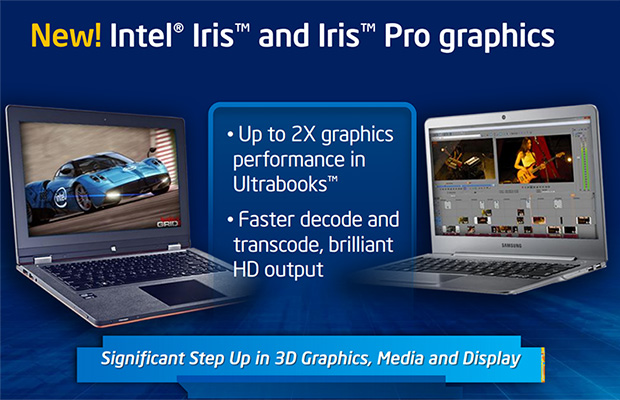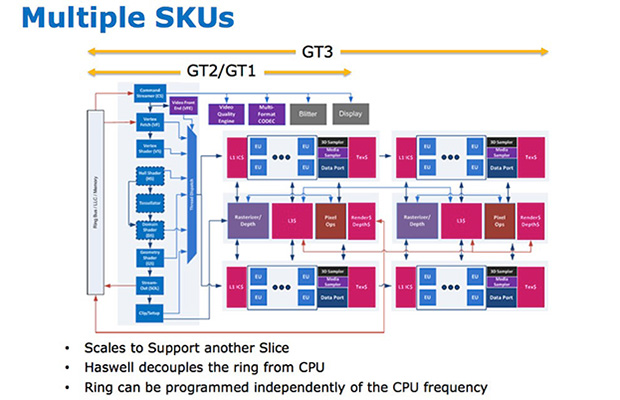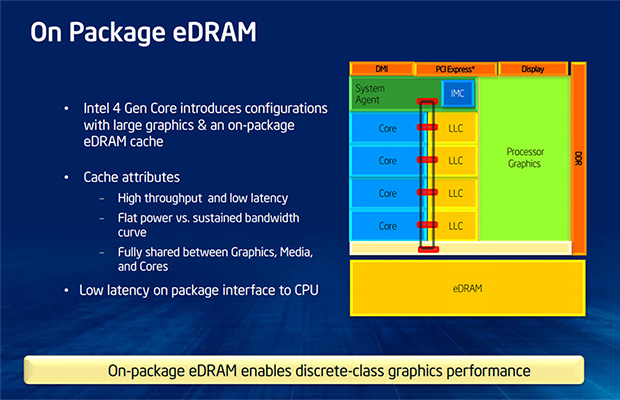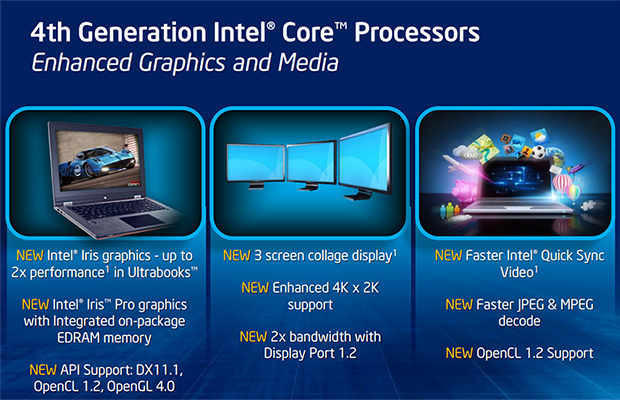Iris Graphics
Intel has made progress with its integrated graphics processor in recent years, yet there's no escaping the fact that the company's HD Graphics have lagged behind the competition - namely AMD. The best Ivy Bridge option - HD 4000 - pales in comparison to rival AMD parts, and of course can't hold a candle to even low-end discrete graphics solutions.
With today's devices becoming increasingly media-centric, Intel needs to shake-off its image as a sub-par graphics provider and become, at the very least, competitive. So what can Intel create to compete with AMD's Radeon and Nvidia's GeForce? The answer is Iris.
Launched in unison with Haswell as a fresh Intel brand, Iris is the name given to the company's new generation of IGP. The name is ultimately a clean slate; it's a message to consumers that says "yeah, HD Graphics weren't all that, Iris will absolutely be better."
Question is, will it, and by how much? Intel is officially claiming that fourth-generation Haswell graphics will offer up to double the performance of last-generation Ivy Bridge, but unusually, we aren't being provided with detailed specifications. This wouldn't be a major issue if the fourth-generation IGP came in one flavour, but Haswell's IGP will come in various shapes and sizes.
In order of performance, Haswell's IGP will be available in at least half-a-dozen models; Iris Pro 5200; Iris Pro 5100; HD 5000; HD 4600; HD 4400 and HD 4200. The reason for this is that, unlike Ivy Bridge's HD 4000 IGP, the graphics in Haswell have been deliberately designed to be scalable.
The amount of scalability is reflected in the number of execution units, in what Intel calls a Slice, and the operating frequency of each core will be dependant upon processor positioning.
Intel, for reasons unknown, remains unwilling to disclose the exact composition of each Slice or IGP. Going by rumours, the top-of-the-range Iris Pro 5200 is said to have 40 execution units, while the middle-of-the-pack HD 4600 is believed to have 20. This compares to 16 such units in the best Ivy Bridge chips, but remember, the execution units themselves have been overhauled for Haswell and can't be compared directly.
What we do know is that the Haswell IGP's execution units are more efficient, and that there are more of them. Using the scalability example above, it's also fair to assume that Intel can now further raise IGP performance by increasing the EU count.
Making matters even more interesting, and further illustrating Intel's need to push graphics performance, certain Haswell IGPs will be paired with a dedicated eDRAM frame buffer. Once again, Intel isn't going into specifics - there's no mention of buffer size or speed - but we're told the on-package (not on-die) cache will be accessible to both the CPU and GPU, and will benefit performance in either workload.
The addition of the eDRAM will of course only be available in BGA packages (not socketed, off-the-shelf CPUs), however given the extra thermal requirements of the on-package cache, we aren't expecting to see this optimal performance configuration in Ultrabooks or convertibles. Iris Pro 5200 graphics with a dedicated cache are more likely to appear in high-end laptops, where the aim is to offer a level of graphics performance on par with, say, a GeForce GT 650M discrete graphics card.
It's clear that mobile Haswell IGPs will come in various formats, offering differing levels of performance, but the picture is clearer on the desktop front. At launch, each quad-core desktop Haswell CPU will ship with an HD 4600 IGP. The graphics core, in keeping with all other Haswell parts, can power a three-screen collage mode, displays with a 4Kx2K resolution, and offers support for DisplayPort 1.2, as well as the latest version of Khronos Group's general-purpose compute language, OpenCL 1.2.













